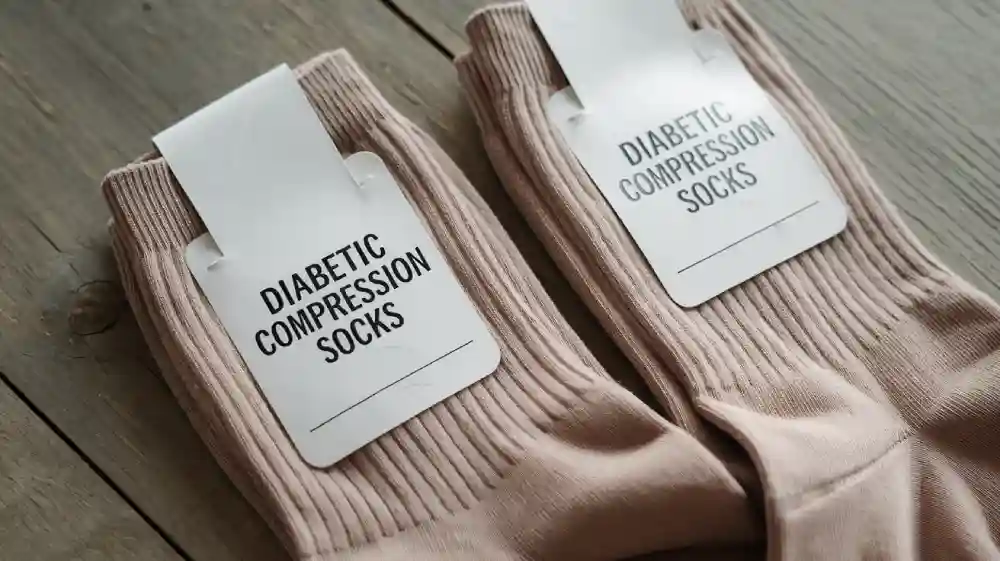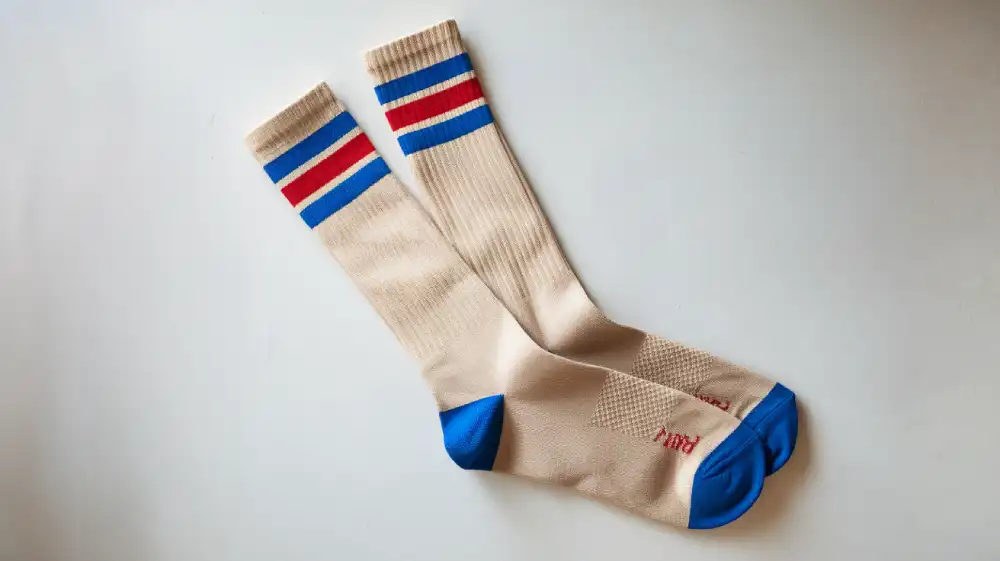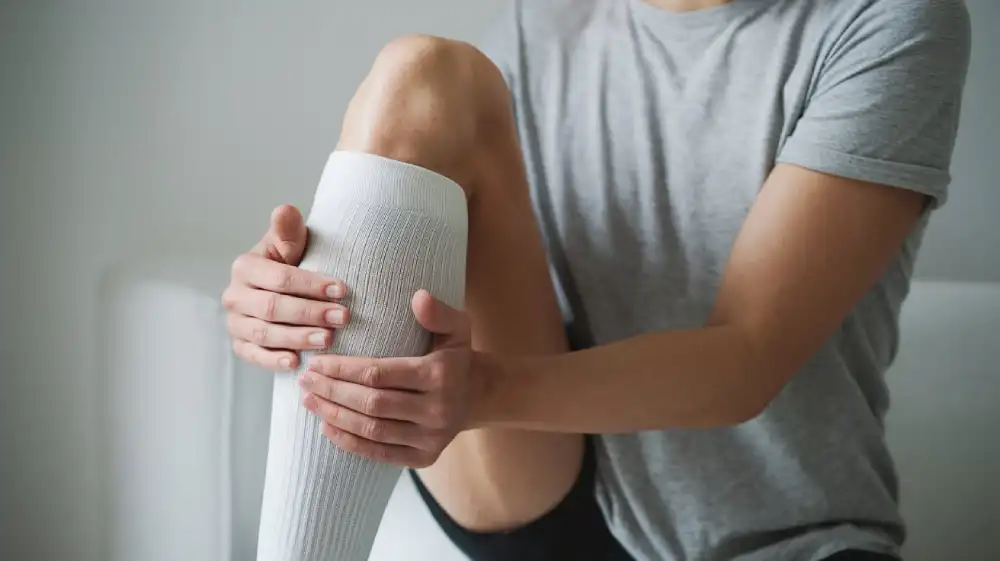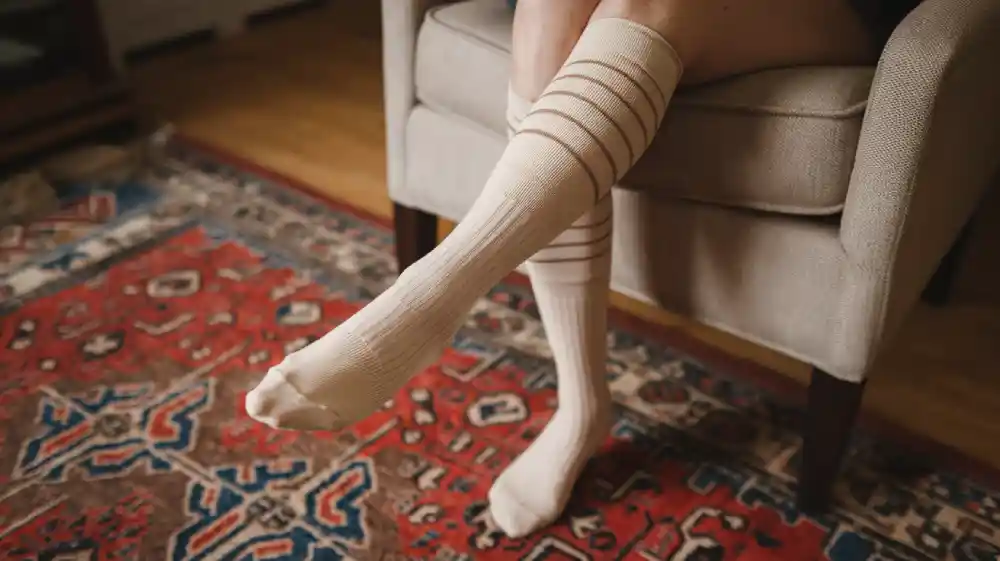
Maintaining foot health is a critical yet often overlooked aspect of managing diabetes. Elevated blood sugar levels can impair circulation and nerve function, making feet particularly vulnerable to a range of complications. From persistent pain and swelling to the risk of ulcers and infections, the challenges are numerous and can significantly impact quality of life. At the same time, circulation problems can interfere with blood flow throughout the body, causing wear and tear on the lining of the nerves, especially in the feet, where blood has to be pumped from the heart to the toes and back again. Poor circulation can lead to a number of problems in the feet, such as slow-healing wounds, impaired balance and falls, and a high risk of amputation.
This is where compression socks come into play. Engineered to enhance blood flow and provide essential support, these specialized compression socks offer a proactive approach to preventing and alleviating common diabetic foot issues. In this comprehensive guide, we explore how compression socks can be a game-changer for individuals living with diabetes, offering both comfort and crucial health benefits. Whether you’re newly diagnosed or seeking better ways to manage your condition, understanding the role of compression therapy can empower you to take control of your foot health and overall well-being.
What Are Compression Socks?
Understanding the intricacies of specialized hosiery is essential for anyone managing diabetic foot health. These garments are meticulously designed to provide targeted support, making a significant difference in daily comfort and long-term well-being.
- Defining Compression Socks: Types and Features
Compression sock comes in various forms, each tailored to specific needs. Graduated compression, which is tighter at the ankle and gradually loosens up the leg, is the most common type. Materials range from breathable cotton blends to advanced moisture-wicking fabrics, ensuring both comfort and functionality. Additional features may include seamless toes to prevent irritation and reinforced heels for durability, catering to the unique demands of diabetic care.
- How Compression Socks Differ from Regular Socks
Unlike regular socks that offer minimal comfort, these specialized compression socks apply consistent pressure to the legs. This pressure enhances blood flow, reducing the risk of swelling and fatigue. Regular socks typically lack the graduated compression necessary to achieve these therapeutic benefits, making them less effective for individuals requiring enhanced circulation management.

How Compression Socks Differ from Diabetic Socks
Design Differences
- Compression Socks: Usually more elastic and designed with graduated compression, the pressure gradually decreases from the ankle to the calf to promote blood return. Some compression socks may cover the entire calf or even the thigh to provide more comprehensive compression support.
- Diabetic socks: focus more on reducing seams to minimize friction on the skin of the foot; the sole portion may have a thickened design to provide better cushioning and protection; the top usually has a loose closure to avoid excessive compression on the leg.
Functional Differences
- Compression socks: the main function is to improve blood circulation, reduce swelling and prevent blood clots, which is effective for people with fatigued and swollen legs due to prolonged standing or sitting, and is also suitable for diabetic patients to relieve their leg symptoms.
- Diabetic socks: In addition to the basic comfort and protection functions, they also help diabetic patients to keep their feet dry, prevent infections, and reduce foot injuries caused by neuropathy and blood circulation problems.
The Science Behind Compression Therapy
At the core of this technology lies the principle of graduated compression, which counteracts the effects of gravity and promotes venous return. By exerting controlled pressure, these garments help maintain optimal blood flow, essential for healing and preventing complications. Scientific studies have consistently demonstrated the efficacy of compression therapy in managing chronic conditions, underscoring its value in comprehensive diabetic care.
Benefits of Compression Socks for Diabetics
Enhancing Blood Circulation and Reducing Swelling
Effective blood flow is vital for maintaining healthy extremities, particularly for individuals managing diabetes. These specialized hosiery apply graduated pressure, which assists in improving venous return—the movement of blood back towards the heart. Enhanced circulation helps minimize fluid accumulation in the lower legs and feet, significantly reducing swelling and discomfort. By facilitating better nutrient and oxygen delivery to foot tissues, compression wear supports overall foot health and vitality.

Preventing Ulcers and Infections in Diabetic Feet
Diabetes can compromise the body’s ability to heal, making foot ulcers and infections a serious concern. Compression garments play a crucial role in mitigating these risks by maintaining optimal blood flow and reducing areas where blood may stagnate. This continuous support helps prevent the formation of ulcers, which are difficult to heal and can lead to more severe complications if untreated. Additionally, many diabetic-specific socks incorporate antimicrobial properties, offering an extra layer of protection against infections and promoting a healthier foot environment.
Blister Prevention, Alleviating Pain and Discomfort
Daily activities often place significant stress on the feet, leading to blisters and persistent pain, especially for those with diabetes. Compression hosiery are designed to provide cushioning and reduce friction, which helps prevent blister formation caused by repetitive movement and pressure. Moreover, the consistent compression stabilizes muscles and joints, alleviating pain and reducing fatigue from prolonged standing or walking. This combination of blister prevention and pain relief enhances overall comfort, enabling individuals to maintain an active and healthy lifestyle with fewer interruptions from foot-related issues.
Choosing the Right Compression Socks for Diabetes
Selecting the appropriate hosiery is essential to maximize benefits and ensure comfort for individuals managing diabetes. With a variety of options available, it’s important to consider several key factors to find the best fit for your specific needs.
- Consult Doctors for Advice
Before incorporating specialized garments into your routine, it’s crucial to seek guidance from a healthcare professional. A medical expert can assess your individual health status, including circulation and any existing foot conditions, to recommend the most suitable type and compression strength. Personalized advice ensures that your choice aligns with your medical requirements, enhancing both safety and effectiveness.

- Compression Levels
Compression wear is available in different pressure levels, typically measured in millimeters of mercury (mmHg). The appropriate level depends on the severity of your circulation issues and your doctor’s recommendations. Light compression (8-15 mmHg) is generally suitable for daily wear, providing some support and comfort while helping to improve mild swelling and fatigue. Medium compression (15-20 mmHg) is often recommended for most diabetic patients to enhance blood circulation and alleviate leg discomfort. High compression (20-30 mmHg or higher) is typically used to address severe venous disease or significant edema but should always be used under medical supervision to avoid compromising blood circulation. Choosing the right compression level ensures optimal support without causing discomfort or restricting blood flow.
- Material and Comfort
The fabric composition plays a vital role in both comfort and functionality. Opt for breathable, moisture-wicking materials that help keep feet dry and reduce the risk of skin irritation. Cotton is a great choice for daily wear, offering softness, breathability, and the ability to keep feet dry while reducing odor and irritation. Wool or wool blends provide excellent warmth for colder weather or for individuals prone to cold feet, along with some moisture-wicking properties. Synthetic materials like nylon and spandex deliver superior elasticity and durability, and many also include special features such as antibacterial and anti-odor properties. Additionally, seamless designs and cushioned soles can enhance comfort, making it easier to wear the garments throughout the day without irritation.
- Proper Size
Ensuring the correct fit is essential for the effectiveness of compression garments. Accurate measurements of your legs, including the circumference of your ankle, calf, and sometimes thigh, as well as the length from heel to knee or thigh, are necessary. Ill-fitting hosiery can either fail to provide adequate support or cause undue pressure, leading to discomfort or restricted circulation. Always refer to sizing charts and, if possible, get professionally fitted to achieve the best results.
By carefully considering these factors—seeking medical advice, selecting appropriate compression levels, choosing comfortable materials, and ensuring the right size—you can optimize the benefits of specialized hosiery in managing diabetic foot health. Making informed choices enhances comfort and contributes to the overall effectiveness of your diabetes care regimen.

Potential Risks of Using Compression Socks
While these specialized garments are designed to offer significant advantages, they can also come with potential drawbacks if not used properly. Understanding these risks ensures safe and effective usage.
- Obstruction of Blood Flow
When worn incorrectly or if the size is unsuitable, these socks may compress the legs excessively. This can hinder proper circulation, especially for individuals with severe arterial disease or other vascular conditions. Choosing the correct fit is critical to avoid complications.
- Skin Sensitivity or Irritation
Some individuals may experience irritation, especially if the socks are made from materials that don’t suit their skin type. Additionally, prolonged use without proper hygiene can lead to itchiness or even rashes. Always check for material compatibility and maintain cleanliness to minimize skin issues.
- Delayed Recognition of Underlying Conditions
Relying solely on these garments to address symptoms may lead to a delay in diagnosing other health problems. For example, persistent swelling or discomfort could indicate a more serious issue requiring medical attention. Regular check-ups with a healthcare provider are essential to prevent oversight.
By understanding these potential risks, users can maximize benefits while reducing unwanted side effects.

How to Properly Use and Care for Compression Socks?
To make the most of these supportive garments, it’s essential to know how to wear them correctly and take care of them to maintain their effectiveness over time. Below is a practical guide to help users maximize their benefits.
Step-by-Step Guide to Wearing Them Correctly
- Start with Clean and Dry Skin: Ensure your legs are free from moisture to make the process smoother.
- Position the Sock Properly: Gather the fabric at the toes and slowly slide it over your foot. Gradually pull it up your leg without twisting or bunching the material.
- Adjust for Comfort: Make sure there are no wrinkles or folds, as this can create pressure points. The top band should sit flat against your skin without rolling down.
Maintenance Tips to Ensure Longevity and Effectiveness
- Wash After Each Use: Clean them with mild soap and lukewarm water to remove sweat and maintain elasticity. Avoid using bleach or fabric softeners.
- Air-Dry Only: Lay them flat to dry rather than using a dryer, as heat can damage the fibers.
- Inspect Regularly: Check for wear and tear, such as thinning fabric or stretched-out bands, which may reduce their support.
Usage Notes
- Wearing the Wrong Size: Ill-fitting garments can either cause discomfort or fail to provide adequate support. Always measure your legs as per the manufacturer’s guidelines.
- Skipping Breaks: While they are safe for prolonged use, removing them periodically allows your legs to breathe.
- Neglecting Regular Cleaning: Failing to clean them can lead to hygiene issues, affecting both skin health and the garment’s durability.
- Avoid wearing the same pair of socks continuously for a long period of time: socks should be changed every day to keep feet clean, reduce bacterial and fungal growth, and lower the risk of infection.
- Proper wearing and removing: avoid excessive pulling on the socks when wearing to prevent damage; handle them carefully when removing to avoid scratching the skin. For compression socks, they can be worn in specific ways, such as turning the sock partially inside out, placing the foot into the pocket formed first, and then gradually pulling it upwards and adjusting it.
- Pay attention to the condition of your feet: Check your feet regularly for abnormalities such as redness, swelling, pain, ulcers, etc. If discomfort occurs or symptoms worsen, seek medical attention and adjust the way you wear your socks or change the type of socks.

Future Trends in Compression Therapy for Diabetes Management
Compression therapy is constantly evolving to address the unique challenges faced by individuals with diabetes. With advancements in materials, technology, and medical research, the future holds promising solutions to improve comfort, efficacy, and overall health outcomes. Here’s a look at emerging trends and innovations.
- Advanced Materials and Design
Innovations in fabric technology will lead to more effective and comfortable compression garments. Future products are likely to utilize moisture-wicking materials combined with anti-microbial properties to prevent infections, a common concern for diabetics. Research indicates that improved fabric technologies can also enhance breathability and comfort, encouraging consistent use among patients.
- Smart Wearable Technology Integration
The rise of smart wearable technology is set to revolutionize how compression therapy is administered and monitored. Future compression socks may incorporate sensors that track blood flow and pressure, providing real-time data to both patients and healthcare providers. This integration can enhance personalized treatment plans, allowing adjustments based on individual needs.
- Personalized Compression Levels
As understanding of diabetes progresses, there will be a shift towards personalized compression levels tailored to individual patient profiles. This could involve using data from wearable devices to determine the optimal level of compression needed for each user, thereby maximizing benefits while minimizing risks associated with improper fit or excessive pressure.
- Sustainable and Eco-Friendly Materials
As sustainability becomes a global priority, the compression garment industry is exploring biodegradable and recycled materials. These eco-conscious options reduce environmental impact and cater to growing consumer demand for ethical products. For instance, a 2024 survey by Global Health Textiles found that 62% of consumers preferred sustainable medical wear, suggesting a significant shift in buying preferences.
- Preventative Care Through Early Detection
New designs are being developed to address issues before they arise. These products incorporate sensors to detect subtle changes in skin condition or pressure points, alerting users to take preventative action. Research presented at the International Conference on Diabetes in 2024 suggests that such systems could reduce the incidence of diabetic foot complications by up to 30%. Additionally, personal medical devices are already making a difference, with 28% of Americans reporting that their devices have alerted them to potential health problems. This highlights the growing role of technology in identifying issues early and improving health outcomes.
- AI-Powered Recommendations
Artificial intelligence is being integrated into the compression therapy process, providing users with tailored suggestions based on their medical history and daily activity patterns. These AI-driven tools, already piloted in some healthcare apps, are expected to become mainstream by 2030, streamlining treatment plans and enhancing outcomes.
Conclusion
Compression socks are a powerful tool for diabetes management, offering numerous benefits like improved circulation, reduced swelling, and prevention of foot complications. While they come with potential risks, proper use and care can ensure safety and effectiveness. With innovations like smart technologies, advanced materials, and personalized designs, the future of compression therapy is brighter than ever.
If you’re a brand or retailer looking to expand your product offerings with custom compression socks, now is the time to act. By partnering with a reliable manufacturer, you can deliver high-quality, innovative solutions tailored to your customers’ needs. Contact us today to discuss how we can help bring your vision to life with premium custom compression socks.
FAQs
Q1. Are compression socks safe for all diabetics?
Not all diabetics should wear compression socks. Individuals with severe arterial insufficiency or other specific conditions should consult their healthcare provider before using them. A doctor can assess whether compression therapy is appropriate based on an individual’s health status.
Q2. How long should diabetics wear compression socks?
The duration for wearing compression socks varies based on individual needs and medical advice. Some may wear them throughout the day, while others might use them for specific activities or periods. It’s essential to follow a healthcare provider’s recommendations regarding usage.
Q3. Can wearing compression socks prevent diabetic foot injuries?
While compression socks can help maintain circulation and provide support, they should not be solely relied upon to prevent foot injuries. Diabetics should also practice good foot hygiene, inspect their feet regularly, and manage their blood sugar levels to minimize injury risk.
Q4. What is the recommended compression level for diabetic socks?
For diabetics, mild compression levels of 18-25 mmHg are often recommended. Studies have shown that this range can effectively reduce lower extremity edema without compromising vascularity, making it a safe option for individuals with diabetes.
Can compression socks help prevent complications like DVT in diabetics?
Yes, wearing compression socks can significantly lower the risk of deep vein thrombosis (DVT) by promoting better blood flow and reducing blood pooling in the legs. This is particularly important for diabetics, who may have an increased risk of vascular complications.
